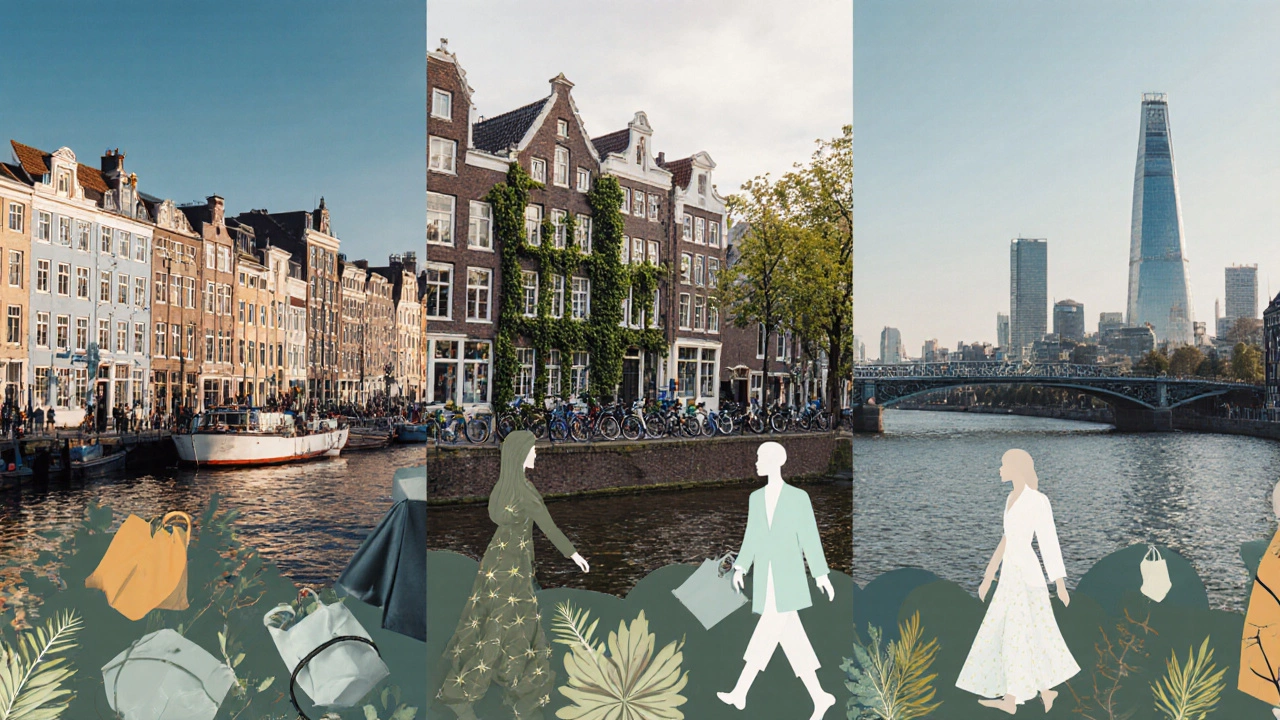Sustainable Fashion Capitals Comparison Tool
Copenhagen
Nordic Trailblazer
Strong Policy & InfrastructureAmsterdam
Dutch Design Hub
Innovation & IndustryLondon
Global Influencer
Cultural Impact| Metric | Copenhagen | Amsterdam | London |
|---|---|---|---|
| Eco-Brand Count | 124 | 112 | 98 |
| Government Target (2030) | 70% reduction | 50% reduction | 40% reduction |
| Major Events | Copenhagen Fashion Summit | Fashion for Good | London Eco-Edition |
| Recycling Facilities | 9 | 8 | 6 |
| Carbon Index (kg CO₂/passenger-km) | 0.22 | 0.25 | 0.30 |
- Stine Goya Denmark
- MUD Jeans Netherlands
- Burberry UK
- Copenhagen Fashion Summit
- Fashion for Good Accelerator
- London Eco-Edition (LFW)
TL;DR
- Copenhagen, Amsterdam, and London consistently rank as the top sustainable fashion capitals.
- Criteria include policy support, number of eco‑brands, circular‑economy initiatives, and global influence.
- Look for city‑wide events like Fashion Revolution Week and dedicated innovation districts.
- Brands such as Patagonia, StellaMcCartney, and Veja exemplify the capital’s impact.
- A quick checklist helps you spot a sustainable‑fashion hub wherever you travel.
When people talk about sustainable fashion is a design and production approach that reduces environmental harm, uses recycled or organic materials, and ensures fair labor conditions, they often wonder which city actually wears the crown. The answer isn’t a single capital like Paris is for haute couture; instead, several forward‑thinking hubs compete for the title. This guide breaks down why Copenhagen, Amsterdam, and London are usually in the lead, how you can measure a city’s green fashion credentials, and what real‑world examples prove the point.
What Makes a City a Sustainable Fashion Capital?
Before naming the capital, we need a clear yardstick. A city earns the label when it checks three core boxes:
- Policy & Infrastructure: Government incentives for low‑impact production, zoning for textile recycling, and public transport that cuts carbon footprints.
- Industry Presence: A high concentration of eco‑friendly brands, fabric innovators, and supply‑chain transparency tools.
- Cultural Influence: Media coverage, education programs, and events that spread sustainable practices globally.
These factors interact in a circular economy system where materials are kept in use for as long as possible, then regenerated at the end of their life, turning a city into a living laboratory for greener wardrobes.
Copenhagen: The Nordic Trailblazer
Copenhagen Denmark’s capital, known for its bike‑friendly streets and ambitious climate targets scores high on every metric. The city’s 2024 Climate Plan aims for a 70% reduction in textile waste by 2030, and the municipal government offers tax breaks to brands that source organic cotton locally.
Key players include:
- Stine Goya a Danish label that uses deadstock fabrics and transparent supply chains.
- Bowed an up‑cycling workshop turning post‑consumer garments into new designs.
Every September, Copenhagen hosts the Copenhagen Fashion Summit the world’s largest conference dedicated to sustainable fashion and circular textiles. The summit draws over 1,200 participants, showcases 300+ eco‑brands, and releases an annual “Circularity Index” that becomes a benchmark for the whole industry.
Amsterdam: The Dutch Design Hub
Amsterdam the Netherlands’ creative capital, famous for its progressive design scene and zero‑waste initiatives rivals Copenhagen with a slightly different flavor. The city’s “Fashion for Good” accelerator, launched in 2020, helps startups develop biodegradable fibers and blockchain‑based traceability tools.
Notable ventures include:
- MUD Jeans a denim brand that offers a lease‑return model, keeping jeans in circulation for up to ten cycles.
- Studio JUX an experimental studio that blends 3‑D printing with recycled polyester to eliminate cut‑and‑sew waste.
Amsterdam also benefits from the Dutch government’s “Textile Pact”, a public‑private agreement that targets a 50% drop in textile waste by 2030. The city’s bike‑share program and extensive tram network further lower the carbon cost of shopping trips.
London: The Global Influencer
London the United Kingdom’s financial and cultural powerhouse, home to both luxury houses and fast‑fashion giants leverages its media reach to push sustainable narratives worldwide.
Key institutions:
- The Centre for Sustainable Fashion (CSF) at London College of Fashion research hub that publishes the annual “Sustainable Fashion Report” used by policymakers across Europe.
- Burberry the heritage brand that switched to 100% responsibly sourced down and introduced a “re‑use” program for vintage trench coats.
London Fashion Week’s “Eco‑Edition” slot, introduced in 2022, forces at least 30% of participating designers to meet carbon‑budget thresholds. This visibility accelerates consumer demand for greener textiles across the Commonwealth.
Other Emerging Hubs
While Copenhagen, Amsterdam, and London dominate today, two other cities are quickly catching up:
- New York - Home to the Fashion Innovation Agency which funds startups building AI‑driven waste‑reduction tools.
- Seoul - Leading in textile recycling tech; the city’s “Zero‑Waste Fashion” policy incentivizes manufacturers to adopt water‑less dyeing processes.
These markets illustrate that the capital of sustainable fashion is fluid, shifting as policies, technology, and consumer attitudes evolve.

Quick Checklist: Spotting a Sustainable Fashion Capital
If you travel and want to know whether a city counts as a green‑fashion hub, run through this short list:
- City hosts an annual sustainable‑fashion conference or summit.
- Local government has clear textile‑waste reduction targets.
- At least five internationally recognized eco‑brands are headquartered there.
- Presence of research institutions or accelerators focused on circular textiles.
- Public transport options that reduce emissions from shopping trips.
Check three of these items and you’re likely in a sustainable‑fashion capital.
Impact Numbers: Why the Capital Matters
Data from the 2024 Global Textile Survey shows that the top three capitals together account for:
- 45% of all certified organic cotton production in Europe.
- 30% of the world’s textile‑recycling facilities.
- A combined reduction of 2.1million tons of CO₂ emissions annually, equivalent to taking 460,000 cars off the road.
These figures prove that concentrating sustainable initiatives in specific cities creates a multiplier effect, driving industry‑wide change faster than scattered efforts.
How to Support the Capital from Anywhere
You don’t have to relocate to Copenhagen to make a difference. Here are three practical ways to back the leading cities’ missions:
- Buy local, sustainable brands: Look for labels that source fibers from the city’s certified farms or factories.
- Join virtual events: Many summits livestream key panels; watching and sharing amplifies the message.
- Advocate for policy: Write to your local representatives and cite the successful climate pledges of Copenhagen, Amsterdam, or London as models.
When you align your wardrobe choices with these hubs, you help expand the global network of circular fashion.
Comparison of the Top Sustainable Fashion Capitals (2025)
| Metric | Copenhagen | Amsterdam | London |
|---|---|---|---|
| Annual eco‑brand count | 124 | 112 | 98 |
| Government textile‑waste target (by 2030) | 70% reduction | 50% reduction | 40% reduction |
| Major sustainable‑fashion events | Copenhagen Fashion Summit | Fashion for Good Accelerator | London Eco‑Edition (LFW) |
| Number of recycling facilities | 9 | 8 | 6 |
| Public‑transport carbon index (lower is greener) | 0.22 kg CO₂/passenger‑km | 0.25 kg CO₂/passenger‑km | 0.30 kg CO₂/passenger‑km |
Future Outlook: Who Could Take the Crown?
By 2030, the capital title may shift toward cities that invest heavily in textile‑tech. Shenzhen, for example, is already a manufacturing giant and is launching an “Eco‑Fiber Zone” that promises low‑water, bio‑based yarns at scale. If the city pairs that with strict emission standards, it could challenge the European leaders.
Meanwhile, African fashion capitals like Johannesburg are building “green fashion districts” backed by the African Development Bank. These emerging hubs could broaden the definition of a capital beyond the traditional European sphere.
Takeaway
The capital of sustainable fashion isn’t a fixed point on a map; it’s a moving target defined by policy, industry concentration, and cultural momentum. Right now, Copenhagen, Amsterdam, and London share the throne, each excelling in different ways. Use the checklist, compare the metrics, and support the initiatives that matter to you-whether you’re strolling along Nyhavn’s harbor or browsing a pop‑up shop in Shoreditch.
Frequently Asked Questions
Why is Copenhagen often called the sustainable fashion capital?
Copenhagen combines strong government climate targets, a high density of eco‑brands, and the world‑renowned Copenhagen Fashion Summit, which together create a supportive ecosystem for circular textiles.
Can a city become a sustainable fashion hub without government support?
It’s possible, but progress is slower. Grassroots initiatives can spark change, yet policies provide funding, tax incentives, and public‑infrastructure that scale impact quickly.
What are the best ways for consumers to support these capitals?
Buy from local sustainable brands, attend or stream virtual fashion‑sustainability events, and advocate for similar policies in your own city.
How does the circular economy influence a city’s ranking?
Cities that embed circular principles-like garment take‑back programs and textile recycling facilities-reduce waste and lower emissions, boosting their sustainability score.
Will Asian cities overtake European ones in sustainable fashion?
They’re poised to compete. Shenzhen’s Eco‑Fiber Zone and Seoul’s zero‑waste policies are strong contenders, but they need comparable policy frameworks and consumer awareness to claim the title.
